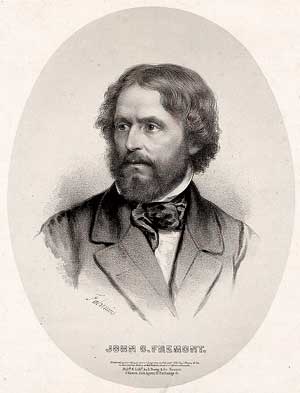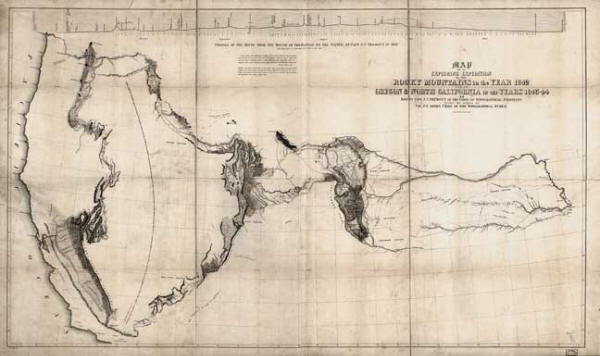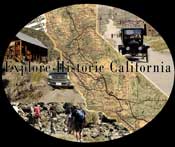|
Three years before the Donner party made its fateful early
winter Sierra Nevada crossing, the "Great Pathfinder", John C.
Fremont, set out on his second expedition, setting precedence that
should have stood as foreboding to any and all choosing to head west
following a similar path. The journey began in the spring of 1843
with orders to survey the Oregon Trail from the Rocky Mountains west
to the Pacific.
 |
|
Portrait of John C.
Fremont, published 1861.
(Library of Congress
collection) |
Thirty nine men were picked to join him, at least six of
which had traveled with him before. In addition to the usual
camping, hunting, food, scientific supplies and trail animals, his
party was outfitted with the infamous Howitzer that would become a
bullet in his side long after it was abandoned along the trail.
As Fremont bid farewell to his wife a mere six months after
his return from his first expedition, the couple took some comfort
knowing they would only be separated for eight months. Jessie Benton
Fremont was a staunch supporter of her husband, and wise in the ways
of discovery, expansion, and politics thanks to her status as
daughter of Senator Thomas Hart Benton.
Even as her husband’s party outfitted themselves for their
adventure at a stopping point four hundred miles away from St. Louis
where the couple had said their goodbyes, she made sure nothing
detained his mission. After his departure, upon the arrival of a
government letter addressed to her husband regarding the necessity
of the 12 pound Howitzer taken along for protection against Indians,
she quickly intercepted.
Worried about political implications and the possibility of
her husband not getting a jump start on the harsh winter snows in
the mountainous country along his intended route, instead of the
sending the letter addressed to him, she entrusted two messengers on
horseback with her words urging: “Only trust me and go…”
The sojourn to Oregon went by relatively uneventful as
expeditions go with the usual fluctuations of food and game, a bout
of sickness amongst the men from tainted buffalo meat, as well as
both excited and cautious encounters with various Indian tribes,
mountain men, trappers, emigrant parties, and wild animals. The
trail breaking and path finding altered between smooth and
precipitous over desert and mountainous terrain, in all manner of
inclement and good weather. Appropriate notations of flora, fauna,
geology, geography, astronomy, meteorology and various instrumental
observations were marked in journals. Within six months Fremont and
his men accomplished all that had been expected of them. Mapping and
place naming along the way would insure that Fremont and his men
were not forgotten in history. It was now time to head back to
Missouri with their findings.
On January 18, 1844, Fremont suddenly made the decision to
abandon his Eastern course and to cross the Sierra Nevada towards
the Valley of the Sacramento. According to his memoirs his ”decision
was heard with joy by the people and diffused new life throughout
the camp.”
In the next few weeks encounters with Indians warned of
dangers ahead.
 |
|
Map of an exploring
expedition to the Rocky Mountains in the year 1842 and
to Oregon & North California in the years 1843-44 / by
Brevet Capt. J.C. Frémont of the Corps of Topographical
Engineers; lith. by E. Weber Co., Baltimore, Md.
(Library of Congress,
Geography and Map Division) |
Excerpts for Fremont's journals (John
Charles Fremont, Explorer of the American West, Memoirs of My
Life-Second Expedition 1843-1844)
|
January 28, 1844
…Several
Indians appeared on the hillside, reconnoitering the
camp, and were induced to come in; others came in
during the afternoon; and in the evening we held a
council…
…We explained to the Indians that
we were endeavoring to find a passage across the
mountains into the country of the whites, whom w
were going to see; and told them that we wished them
to bring us a guide, to whom we would give presents
of scarlet cloth and other articles, which were
shown to them. They looked at the reward we
offered, and conferred with each other, but pointed
to the snow on the mountain, and drew their hands
across their necks, and raised them above their
heads, to show the depth; and signified that it was
impossible for us to get through.
|
|
January 31, 1844
…it began
to snow heavily, with very cold weather. The
Indians had only the usual scanty covering, and
appeared to suffer greatly from the cold. All left
us except our guide. Half-hidden by the storm, the
mountains looked dreary; and, as night began to
approach, the guide showed great reluctance to go
forward. I place him between two rifles, for the way
began to be difficult. Traveling a little farther,
we struck a ravine, which the Indian said would
conduct us to the river; and as the poor fellow
suffered greatly, shivering in the snow which fell
upon his naked skin, I would not detain him any
longer; and he ran off to the mountain where he said
there was a hut near by. He had kept the blue and
scarlet cloth I had given him tightly rolled up,
preferring rather to endure the cold than get them
wet.
…In the course of the afternoon,
one of the men had a foot frost-bitten.
We had made a forced march of
twenty-six miles, and three miles had given out on
the road. Up to this point, with the exception of
two stolen by Indians, we had lost none of the
horses which had been brought from the Columbia
River, and a number of these were still strong and
in tolerably good order. We had now sixty-seven
animals in the band.
…We had scarcely lighted our
fires, when the camp was crowded with nearly naked
Indians….We gathered together a few of the most
intelligent of the Indians, and held this evening an
interesting council. I told them that we had come
from a very far country, having been traveling now
nearly a year, and that we were desirous simply to
go across the mountain into the country of the other
whites. There were two who appeared particularly
intelligent—one, a somewhat old man. He told me
that, before the snows fell, it was six sleeps to
the place where the whites lived, but that now it
was impossible to cross the mountain on account of
the deep snow…”
|
|
February 4, 1844
…Tonight we had no shelter, but we
made a large fire around the trunk of one of the
huge pines; and covering snow with small boughs, on
which we spread our blankets, soon made ourselves
comfortable. The night was bright and clear, and
though the thermometer was only down to 10 degrees,
a strong wind sprang up at sundown, made it
intensely cold; and this was one of the bitterest
nights during the journey.
…Two Indians joined our party
here; and one of them an old man, immediately began
to harangue us saying that ourselves and animals
would perish in the snow, and that if we would go
back, he would show us another and better way across
the mountain. …..
…We had now begun to understand
some words, and with the aid of signs, easily
comprehended the old man’s simple ideas. “Rock upon
rock—rock upon rock—snow upon snow- snow upon snow,”
he said. “Even if you get over the snow, you will
not be able to get down from the mountains.”
|
Bibliography
A Newer World-Kit Carson, John C. Fremont, and The Claiming of the
American West
by David Roberts
Simon & Schuster, 2000
Fremont Explorer for a Restless Nation
by Ferol Egan
University of Nevada
Press, 1977
Jessie Benton Fremont
by Pamela Herr
University of Oklahoma
Press, 1987
Memoirs of My Life, John Charles Fremont Explorer of the American
West
New Introduction by
Charles M. Robinson III
Cooper Square Press, 2001
John C. Fremont lithograph and
expedition map
Unites States Library of Congress
http://memory.loc.gov/ammem/gmdhtml/gmdhome.html
|
|
